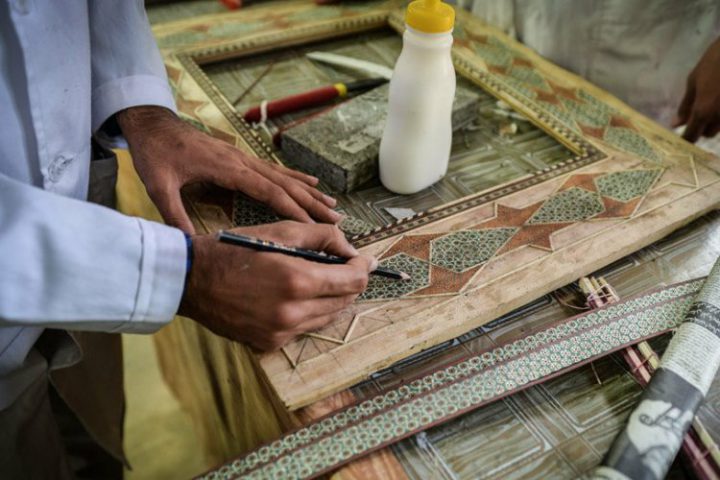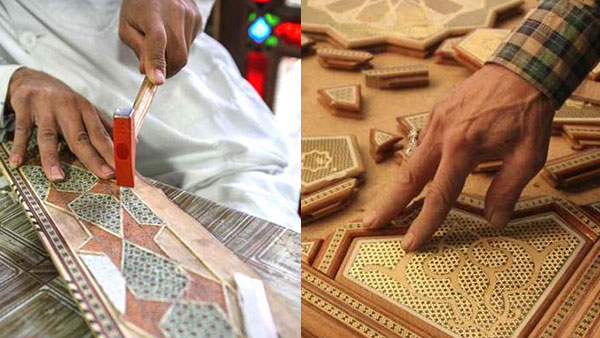One of the most valuable and significant Iranian handicrafts is the art of inlay work. This art is the jewel of our country’s handicrafts ring. Becomes. These triangles are made of wood, metal and bone. The first inlaid works found in Iran 1000 years ago are in the city of Shiraz. Also, this art has been popular since the Safavid era and has reached its peak of prosperity after that. Inlay is obtained from a combination of polygons and geometric shapes whose sides are equal. These shapes are five, six, seven, octagonal or ten-sided. The delicacy of this work is very high and of course it requires a lot of patience.
“The art of inlay has existed in the Middle East for a very long time, even in ancient times,” said Professor Pope, a renowned Iranologist who discovered the origins of the art of inlay. In fact, what the Pope is saying about the history of inlay is about art that has a history of about six hundred years, inspired by handicrafts with a history of several thousand years.

Inlay, inlay or inlay is a work created using small triangles or regular polygons. These geometric shapes are made of different materials such as bone, wood and metals. From woods such as: ebony (black), betel (black and dark brown), walnut (brown), bagham (red), jujube (light reddish brown), orange (light brown), maple (brown) O Roshan), cake, Tabrizi (white) and boxwood (yellow). From bones such as elephants and ivory, camels, cows and horses. Metallic metals include brass, silver and sometimes gold.
It can be said that wood is also imported from India for this purpose. It should also be noted that due to its high price, it is not widely used today. Today, with the help of chemical dyes, they change the color of existing woods to produce various colors such as yellow. , Black and red. Ivory and ivory are also less commonly used, and other bones (especially cow and horse) are painted in colors other than white (eg green). Aluminum and copper are sometimes used in metals.
Applications of inlay work
Examples of inlays used in the past: Inlaid pulpit and roof of the porch of Atiq Mosque in Shiraz, inlaid doors of Timur Palace in Samarkand, flower and bush doors of Bukhara, Golestan Palace hall doors, wooden pulpit of Lebanon Lebanese Mosque, door The inlays are located in the King Abdolazim Hassani Museum, the inlaid room of the Marble Palace and the Khatam Hall of the National Assembly.
The following can also be expressed from the old works of inlay art
- Shrine of Imam Musa Kazem (AS) and Imam Mohammad Taqi (AS) in Kazemin related to the reign of Shah Ismail Safavid
- Imam Hassan Askari (AS) Shrine Fund and also Imam Ali Naqi (AS) Shrine Fund in Samarra during the Safavid period
- The inlay box of the shrine of Narges Khatoon, the mother of Hazrat Mahdi (as), which was built in the same Safavid period.
- The entrance door of Chaharbagh school in Isfahan
- Door Khatam Imamzadeh Shahreza in Ghomsheh (Shahreza)
- Khatam box of the shrine of Hazrat Ali (AS) made during the reign of Karim Khan Zand and installed during the reign of Lotfali Khan Zand
- Khatam box of the shrine of Imam Hussein (AS) and Hazrat Abolfazl (AS) in Karbala
- Tomb of Hazrat Zainab (AS) in the sham
At present, due to its reasonable price and eye-catching beauty, Khatam is used as a tool in most homes, such as: chessboards, jewelry boxes, chocolate eating utensils, etc., and it is also used as an office set and for business advertisements. .

Materials required for inlay work
To do this art, you need the following tools:
- Wood cutting machine
- Wood of trees such as ebony, betel, walnut, baqam, jujube, orange, kahkam-bruised
- Elephant bone and ivory – camel bone – horse bone
- Metal wires: brass-aluminum and some silver
- Oysters – flake yarn – silk – lacquer
Inlaying steps
The process of making an inlay is difficult and long and includes several stages. For example, when making regular geometric pieces, first cut wood and bone with different colors with a special tool with a length of thirty centimeters and a diameter of one to two and a half millimeters (usually in the shape of a triangle). These geometric shapes are also made with metal wires. These wooden, bone and metal triangles are then carefully and skillfully pre-determined according to the plan and glued together with hot glue (hot glue or cold white glue) and fastened with thread. .
This piece is called a “blade”. This work is continued and repeated by gluing the blades together, so that finally, after steps such as pressing, varnishing and polishing, the desired design and shape is produced and inlaid on dishes, objects and products. .
High quality inlay feature
- High quality inlay feature
- The surface of the inlay should be smooth and full
- The color and materials used in the inlay should be uniform
- No change in color and shape
- Restorations and putties are not specified at the work level.
- Symmetry of all balls and shapes on the work surface and angles and sides
- Painting and coating without defects
- The finesse of maps and triangles




